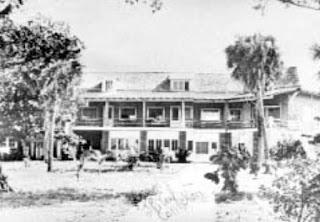 |
| Las Olas Inn - postcard Florida State Archives/Florida Memory |
By Jane Feehan
During the late 1800s, pioneer Frank Stranahan’s activities
centered on his trading post along the New River in what became Fort
Lauderdale. But others came who discovered the beach and were to have an
equally important place in the city’s history and development.
In 1893 Chicagoan and counsel to Standard Oil Hugh T. Birch decided
to pass on an invitation from Henry Flagler to visit Palm Beach and decided to head
south; he set sail on a boat lent to him by Flagler. With only a vague notion
of where he was headed, Birch sought refuge from a storm in what was referred
to at the time as New River Sound, today the site of Bahia Mar. He liked what
he saw and soon bought up beachside property for a reported 75 cents an acre.
Birch introduced fellow Chicagoan J. McGregor Adams to the
beach area by 1896. Adams, a brass manufacturer, also became a heavy beach
investor. One news story reports a beach cottage was built at Las Olas and the
ocean by Adams; other reports say both Birch and Adams had the two-room
structure built but they later split, dividing holdings. The house was constructed by pioneer Ed King who mounted the building
upon molded concrete blocks he made in the sand. Whatever the genesis of
ownership, the structure launched another legacy.
 |
| Las Olas Inn State Archives of Florida |
Adams played host there, it was reported, to an interesting
lineup of guests that included author Theodore Dreiser and Senator Robert
Follette. In 1904, less than 10 years later, Adams died. His estate sold the
beach house and property in 1906 or 1911 (depending on account) to Thomas E.
Watson, one-time Georgia senator and interestingly, author of a noted history
of France.
 |
| 1955 demolition, Courtesy of State Archives of Florida, Florida Memory |
What ensued was a chain of owners of the picturesque inn and property; its story spanned several decades
Watson sold the property and rambling structure a few years
later to D.C. Alexander (a park in his name lies a block south of Las Olas). He
then sold it to G.E. Henry for a reported $30,000—after the Las Olas bridge was
built in 1917. Henry, who built the Broward Hotel, was annoyed by the sound of
surf. He rented the building, known by then as the Las Olas Inn, to Captain and
Mrs. J.B. Vreeland who converted the structure to hotel use.
Henry reclaimed
the inn in 1920 for Broward Hotel staff housing, but sold the package to George
Simon around 1923. Simon didn’t hang on to the property and hotel for long. In
new hands, the Las Olas Inn went into foreclosure in 1926 after the historic
hurricane. Ownership reverted that year to Simon. It proved to be a fortuitous
stroke of luck; Simon’s son, George Jr., ran a successful hotel there for 22
years.
In 1925, a tent colony, popular vacation housing in South
Florida at the time, was set up at the Las Olas Inn. Tents—25 of them—were advertised
as “ventilated and luxurious” offering showers, bathtubs and with the same
service that was available in the main wooden structure. In 1939 the inn, with
several cottages by then, advertised rooms in the main building having an ocean
view facing east and a view of the “New River Sound on the West.” Dining was
available on the veranda.
The Las Olas Inn and its three acres went through several
owners and iterations until 1955, when it was demolished to make way for the Las
Olas Plaza. Many will remember the popular Forum restaurant in the plaza. In 1967,
a 243-room Holiday Inn was built on the site, later home to the Button Lounge.
The property is now the city's Las Olas Oceanside Park, or LOOP, a site for beachgoers and community events.
Note: In March 2018, the Sun-Sentinel
reported land owners Lior Avidor and Aiton “AJ” Yaari, could be looking into
selling nearby property for a huge redevelopment project. They’ve amassed a
string of properties on the beach-facing block just north of Las Olas Boulevard
that includes the historic Elbo Room.
Sources:
Fort Lauderdale News,
Aug. 15, 1925
Fort Lauderdale News,
Nov. 30, 1928
Fort Lauderdale News,
Dec. 1, 1930
Fort Lauderdale News,
March 29, 1930,
Fort Lauderdale News,
May 20, 1931
Fort Lauderdale News,
Nov. 29, 1939
Fort Lauderdale News,
Nov 16, 1943
Fort Lauderdale News,
Jan. 16, 1953
Fort Lauderdale News,
Nov. 16, 1953
Fort Lauderdale News,
Oct. 26, 1954
Fort Lauderdale News,
Aug. 31, 1955
Fort Lauderdale News,
March 4, 1967
Sun-Sentinel, Oct.
7, 1982
Sun-Sentinel,
Aug. 8, 1991
Sun-Sentinel,
March 8, 2018
Tags: Fort Lauderdale history, Fort Lauderdale in the 1800s, Fort Lauderdale in the 1950s, Fort Lauderdale hotel history, Fort Lauderdale Beach history, Jane Feehan, history of Fort Lauderdale











